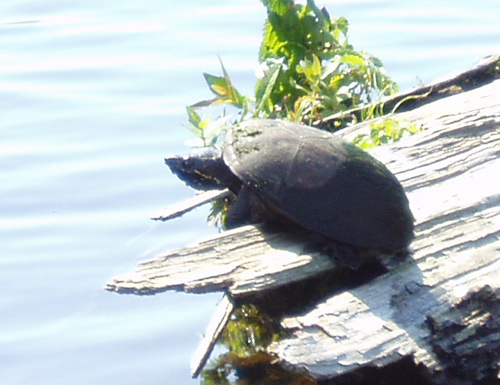The musk turtle, or stinkpot, is a small turtle. Its shell, or carapace, is highly domed and dark brown to black. It's oblong in shape and smooth. The lower shell, or plastron, is very small with one hinge. This allows the turtle to partial withdraw inside its shell. The turtle's body is dark and yellow lines can be seen above and below each eye. Its head is large and the nose is somewhat pointed. Males have a long thick tail. I have found the high-domed, pointy-nosed silhouette of these turtles to be very distinctive. They are easily picked out from among a group of basking painted turtles. The carapace of musk turtles is 3 to 5 1/2 inches long.
Musk turtles range from southern Ontario and coastal Maine to Florida. They extend west to central Texas and north to southern Wisconsin. In Connecticut they are found in streams and rivers in low-lying areas. (I almost always see one or two when kayaking the Wood or Pawckatuck Rivers in nearby Rhode Island.)
These turtles are highly aquatic and live in streams and rivers. They prefer shallow, slow-moving waterways with muddy bottoms.
Musk turtles have an extended breeding season that can last from April to October in New England. The season peaks in April/May and again in September/October. Breeding takes place underwater. Eggs, 1 to 9, are laid in a shallow nest near the water. They are elliptical and off-white with thick shells. Nests may be under rotting stumps, in sandy soil, in mud or sometimes in the walls of muskrat houses. One of the rare times a musk turtle leaves the water is to locate a nesting site. Females are vulnerable to being run over if they cross roads to find a good spot. They may produce 1 or 2 clutches annually. Incubation takes 9 to 12 weeks. Female turtles reach sexual maturity at 9 to 11 years, males at 3 to 4 years. A musk turtle's lifespan is 20 to 50 years.
These turtles hibernate for the winter on the bottom of lakes, ponds or streams. Sometimes they will use a riverbank muskrat burrow. They rarely leave their water home, but crawl out on partially submerged rocks or logs to bask, especially in the spring. Turtles cannot regulate their body temperature internally and must warm themselves in the sun. It is common to see a musk turtle sharing a basking perch with painted turtles. Although they bask in the day, musk turtles are active nocturnally and hunt along the bottoms of waterways.
The musk turtle diet includes snails, aquatic insects, carrion, fish eggs, worms, leeches, larvae, algae and water plants. Young turtles tend to be more carnivorous but as they grow older eat more plant matter. Musk turtles go after bait and are often caught accidentally by fishermen.
Musk turtles are named for their ability to produce musk as a defense. The stinky, yellowish fluid is produced from two pairs of musk glands under the border of their shell. These turtles are feisty and males especially will bite in self defense. Their necks are long and they can reach as far back as their hind limbs to bite.
